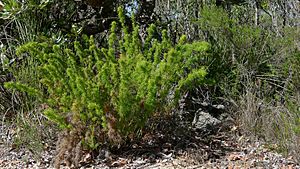Curly sedge facts for kids
Quick facts for kids Curly sedge |
|
|---|---|
 |
|
| Caustis recurvata at Royal National Park, NSW, Australia | |
| Scientific classification | |
| Genus: |
Caustis
|
| Species: |
recurvata
|
The Curly Sedge (scientific name: Caustis recurvata) is a special type of grass-like plant. It belongs to the Cyperaceae family, which is also known as the sedge family. This plant is native to Australia, meaning it naturally grows there.
Contents
What is Curly Sedge?
The Curly Sedge is a perennial plant. This means it lives for more than two years. It grows from underground stems called rhizomes. These rhizomes help the plant spread out. The plant usually grows in a tufted shape, like a clump of grass. It can reach about 1.2 meters (4 feet) tall and wide.
How Does it Look?
The stems of the Curly Sedge are called culms. These culms stand up straight. They can be between 15 to 70 millimeters (0.6 to 2.8 inches) long. Their thickness ranges from 1 to 5 millimeters (0.04 to 0.2 inches). The culms might feel a bit rough or hairy.
Where Does Curly Sedge Grow?
You can find the Curly Sedge in different natural areas. It often grows in sandy areas near the coast. It also likes mountain heathlands. Most of the time, you will see it close to the ocean.
Its Home in Australia
This plant grows along the coast of Australia. Its range stretches from the southeastern part of New South Wales. From there, it goes north along the coast. It reaches into the southeastern areas of Queensland.
Who Discovered Curly Sedge?
The Curly Sedge was first officially described in 1827. A botanist named Kurt Polycarp Joachim Sprengel gave it its scientific name. He wrote about it in his work called Curae Posteriores. This work was published in a larger book called Systema Vegetabilium. Sometimes, plants have other names they were known by before. For the Curly Sedge, two older names were Restio uncinatus and Caustis uncinata.

